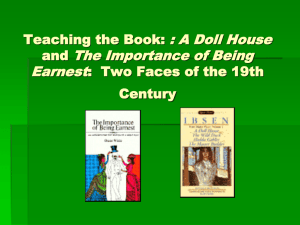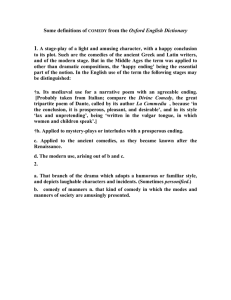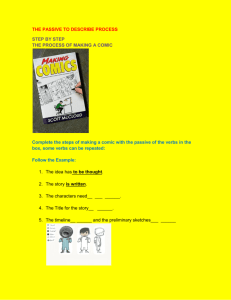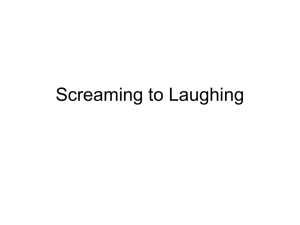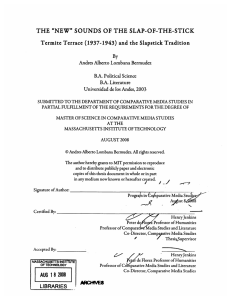Cinema of the Stagnation
advertisement
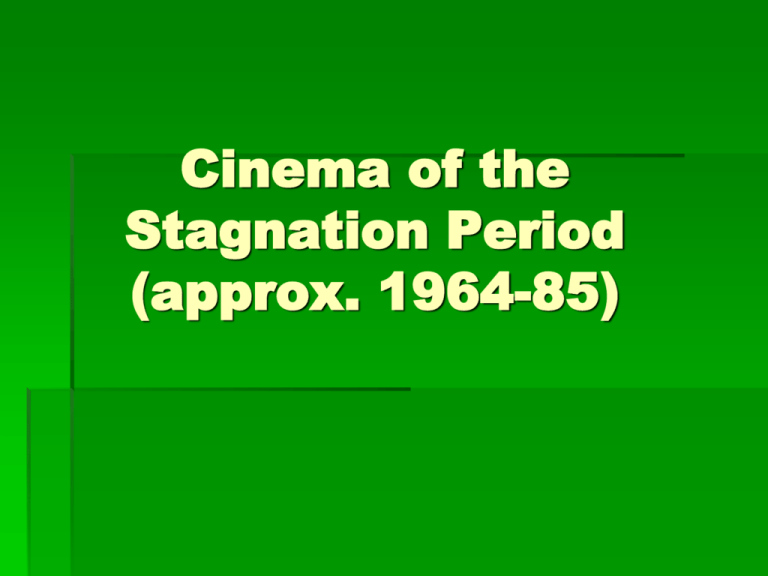
Cinema of the Stagnation Period (approx. 1964-85) Comedies as a response to life’s dullness Under Brezhnev: no economic growth, no positive social changes; free thinking (the dissidents) suppressed. The reign of bureaucracy; bleak life. Lining up for food; “getting” clothes and other stuff. Jokes and comedies as antidotes to the monotony and hopelessness. The differences of the Soviet cultural system from the West Detached from the market place: money provided by the state. No reason to work efficiently. Interaction between the needs of the party and the creative freedom of the individual - testing the limits of the permitted. “Familial" relations between the different camps (Dom Kino). Inefficiencies in the system of control (e.g., approval of script, but no control over the production). Control over distribution. Filmmakers don’t get royalties. The separate strands of film production of the Stagnation “Opportunists” (commercial and political) who worked for the system (Bondarchuk – War and Peace; Menshov - Moscow Does Not Believe in Tears). “Messianic elitism”- Andrei Tarkovsky’sfilms. “Populists” who steered a middle course (EldarRyazanov, Nikita Mikhalkov), giving good middle-brow films. “Entertainment” classics (Leonid Gaidai’s comedies, The White Sun of the Desert (Vladimir Motyl, 1970) Cartoons (the multfilms, мультфильмы) for children (Cheburashka). Film, film, film!(1968) by Fyodor Khitruk The White Sun of the Desert(1970) by Vladimir Motyl Cheburashka(1969) Leonid Gaidai (1923-93) Scriptwriter and director Slapstick comedies with elements of music comedy Best comic actors Popular punch lines Smuggled irony and social criticism Success (up to 76 million tickets sold per film) The great comic trio (Vitsin, Nikulin, and Morgunov) Kidnapping, Caucasian Style (1967) Patriarchal values, money and power vs youth, love, liberated woman Protagonists: young students Villain: a party member who hires petty criminals Song about polar bears Features twist - a “bourgeois” dance in positive light Kidnapping, Caucasian Style (1967) Kidnapping, Caucasian Style (1967) Ivan Vasilievich Switches Profession (1973) Time machine, Ivan the Terrible, “back to the future” theme Colour vs black and white = dream vs reality (ironic comment on the epoch?) The Diamond Arm (1968) Semion, a good family man, gets a chance to go on a cruise and travel abroad Meets a “nice guy” who is a gang member Smugglers take Semion for that guy and put diamonds in the cast on his “broken” arm Back at home, Semion collaborates with the police as a sitting duck while the gangsters try to get the diamonds at all cost Misunderstandings and confusion; happy ending The Diamond Arm (1968) Food for Thought What type of comedy is this? (slapstick/verbal; absurd; dark; farcical; situational/character; screwball; romantic) How would you characterize this comedy? What is Russian about it? Is it different from the comedies you know? Do you sense any irony? What is comic about it, where is the humour? What comic devices are used? (hyperbole; misunderstanding; qui pro quo; culture clash; etc.)
